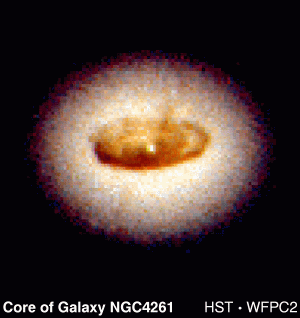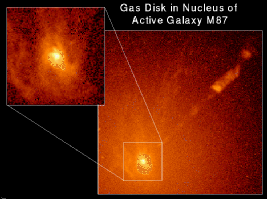What is a black hole?
A black hole is a region of spacetime from which nothing can escape, even light.
To see why this happens, imagine throwing a tennis ball into the air. The harder you throw the tennis ball, the faster it is travelling when it leaves your hand and the higher the ball will go before turning back. If you throw it hard enough it will never return, the gravitational attraction will not be able to pull it back down. The velocity the ball must have to escape is known as the escape velocity and for the earth is about 7 miles a second.
As a body is crushed into a smaller and smaller volume, the gravitational attraction increases, and hence the escape velocity gets bigger. Things have to be thrown harder and harder to escape. Eventually a point is reached when even light, which travels at 186 thousand miles a second, is not travelling fast enough to escape. At this point, nothing can get out as nothing can travel faster than light. This is a black hole.
Do they really exist?
It is impossible to see a black hole directly because no light can escape from them; they are black. But there are good reasons to think they exist.
When a large star has burnt all its fuel it explodes into a supernova. The stuff that is left collapses down to an extremely dense object known as a neutron star. We know that these objects exist because several have been found using radio telescopes.
If the neutron star is too large, the gravitational forces overwhelm the pressure gradients and collapse cannot be halted. The neutron star continues to shrink until it finally becomes a black hole. This mass limit is only a couple of solar masses, that is about twice the mass of our sun, and so we should expect at least a few neutron stars to have this mass. (Our sun is not particularly large; in fact it is quite small.)
A supernova occurs in our galaxy once every 300 years, and in neighbouring galaxies about 500 neutron stars have been identified. Therefore we are quite confident that there should also be some black holes.

This Hubble Space Telescope image contains three main features.
The outer white area is the core or centre of the galaxy NGC4261.
Inside the core there is a brown spiral-shaped disk. It weighs on hundred thousand times as much as our sun.
Because it is rotating we can measure the radii and speed of its constituents, and hence weigh the object at its centre. This object is about as large as our solar system, but weighs 1,200,000,000 times as much as our sun.
This means that gravity is about one million times as strong as on the sun. Almost certainly this object is a black hole.
Black hole in M87

M87 is an active galaxy, one in which we see interesting objects. Near its core (or centre) there is a spiral-shpaed disc of hot gas. The first picture places it in context. The second superposes spectra from opposite sides. This allows us to determine the speed of rotation of the disk and its size. From this we can weigh the size of the invisible object at the centre.
Although the object is no bigger than our solar system it weighs three billion times as much as the sun. This means that gravity is so strong that light cannot escape. We have a black hole.
In the first figure, there is a diagonal line. This is believed to be the passage out of those fortunate particles which escape along the axis of rotation and avoid being swallowed by the black hole.
A black hole is a region of spacetime from which nothing can escape, even light.
To see why this happens, imagine throwing a tennis ball into the air. The harder you throw the tennis ball, the faster it is travelling when it leaves your hand and the higher the ball will go before turning back. If you throw it hard enough it will never return, the gravitational attraction will not be able to pull it back down. The velocity the ball must have to escape is known as the escape velocity and for the earth is about 7 miles a second.
As a body is crushed into a smaller and smaller volume, the gravitational attraction increases, and hence the escape velocity gets bigger. Things have to be thrown harder and harder to escape. Eventually a point is reached when even light, which travels at 186 thousand miles a second, is not travelling fast enough to escape. At this point, nothing can get out as nothing can travel faster than light. This is a black hole.
Do they really exist?
It is impossible to see a black hole directly because no light can escape from them; they are black. But there are good reasons to think they exist.
When a large star has burnt all its fuel it explodes into a supernova. The stuff that is left collapses down to an extremely dense object known as a neutron star. We know that these objects exist because several have been found using radio telescopes.
If the neutron star is too large, the gravitational forces overwhelm the pressure gradients and collapse cannot be halted. The neutron star continues to shrink until it finally becomes a black hole. This mass limit is only a couple of solar masses, that is about twice the mass of our sun, and so we should expect at least a few neutron stars to have this mass. (Our sun is not particularly large; in fact it is quite small.)
A supernova occurs in our galaxy once every 300 years, and in neighbouring galaxies about 500 neutron stars have been identified. Therefore we are quite confident that there should also be some black holes.

This Hubble Space Telescope image contains three main features.
The outer white area is the core or centre of the galaxy NGC4261.
Inside the core there is a brown spiral-shaped disk. It weighs on hundred thousand times as much as our sun.
Because it is rotating we can measure the radii and speed of its constituents, and hence weigh the object at its centre. This object is about as large as our solar system, but weighs 1,200,000,000 times as much as our sun.
This means that gravity is about one million times as strong as on the sun. Almost certainly this object is a black hole.
Black hole in M87

M87 is an active galaxy, one in which we see interesting objects. Near its core (or centre) there is a spiral-shpaed disc of hot gas. The first picture places it in context. The second superposes spectra from opposite sides. This allows us to determine the speed of rotation of the disk and its size. From this we can weigh the size of the invisible object at the centre.
Although the object is no bigger than our solar system it weighs three billion times as much as the sun. This means that gravity is so strong that light cannot escape. We have a black hole.
In the first figure, there is a diagonal line. This is believed to be the passage out of those fortunate particles which escape along the axis of rotation and avoid being swallowed by the black hole.


